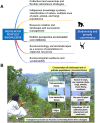Global importance of Indigenous Peoples, their lands, and knowledge systems for saving the world's primates from extinction
- PMID: 35947670
- PMCID: PMC9365284
- DOI: 10.1126/sciadv.abn2927
Global importance of Indigenous Peoples, their lands, and knowledge systems for saving the world's primates from extinction
Abstract
Primates, represented by 521 species, are distributed across 91 countries primarily in the Neotropic, Afrotropic, and Indo-Malayan realms. Primates inhabit a wide range of habitats and play critical roles in sustaining healthy ecosystems that benefit human and nonhuman communities. Approximately 68% of primate species are threatened with extinction because of global pressures to convert their habitats for agricultural production and the extraction of natural resources. Here, we review the scientific literature and conduct a spatial analysis to assess the significance of Indigenous Peoples' lands in safeguarding primate biodiversity. We found that Indigenous Peoples' lands account for 30% of the primate range, and 71% of primate species inhabit these lands. As their range on these lands increases, primate species are less likely to be classified as threatened or have declining populations. Safeguarding Indigenous Peoples' lands, languages, and cultures represents our greatest chance to prevent the extinction of the world's primates.
Figures








Similar articles
-
Human-modified landscapes driving the global primate extinction crisis.Glob Chang Biol. 2023 Oct;29(20):5775-5787. doi: 10.1111/gcb.16902. Epub 2023 Aug 14. Glob Chang Biol. 2023. PMID: 37578114
-
An urgent call-to-action to protect the nonhuman primates and Indigenous Peoples of the Brazilian Amazon.Am J Primatol. 2024 Mar;86(3):e23523. doi: 10.1002/ajp.23523. Epub 2023 May 23. Am J Primatol. 2024. PMID: 37221905
-
Indigenous Peoples' Lands are critical for safeguarding vertebrate diversity across the tropics.Glob Chang Biol. 2024 Jan;30(1):e16981. doi: 10.1111/gcb.16981. Epub 2023 Oct 27. Glob Chang Biol. 2024. PMID: 37888836
-
Impending extinction crisis of the world's primates: Why primates matter.Sci Adv. 2017 Jan 18;3(1):e1600946. doi: 10.1126/sciadv.1600946. eCollection 2017 Jan. Sci Adv. 2017. PMID: 28116351 Free PMC article. Review.
-
Indigenous Peoples: Traditional knowledges, climate change, and health.PLOS Glob Public Health. 2023 Oct 13;3(10):e0002474. doi: 10.1371/journal.pgph.0002474. eCollection 2023. PLOS Glob Public Health. 2023. PMID: 37831713 Free PMC article. Review.
Cited by
-
Local Voices: Perspectives from the Local Community on the Primates of Kakamega Forest, Western Kenya.Animals (Basel). 2023 Nov 11;13(22):3483. doi: 10.3390/ani13223483. Animals (Basel). 2023. PMID: 38003101 Free PMC article.
-
Global impacts of extractive and industrial development projects on Indigenous Peoples' lifeways, lands, and rights.Sci Adv. 2023 Jun 9;9(23):eade9557. doi: 10.1126/sciadv.ade9557. Epub 2023 Jun 7. Sci Adv. 2023. PMID: 37285420 Free PMC article.
-
Primate conservation: A public issue?Am J Primatol. 2025 Jan;87(1):e23632. doi: 10.1002/ajp.23632. Epub 2024 Apr 26. Am J Primatol. 2025. PMID: 38666440 Free PMC article.
-
Recursive self-embedded vocal motifs in wild orangutans.Elife. 2024 Jan 22;12:RP88348. doi: 10.7554/eLife.88348. Elife. 2024. PMID: 38252123 Free PMC article.
-
News and Perspectives: Words matter in primatology.Primates. 2024 Jan;65(1):33-39. doi: 10.1007/s10329-023-01104-6. Epub 2023 Nov 30. Primates. 2024. PMID: 38032520 Free PMC article.
References
-
- Díaz S., Settele J., Brondízio E. S., Ngo H. T., Agard J., Arneth A., Balvanera P., Brauman K. A., Butchart S. H. M., Chan K. M. A., Garibaldi L. A., Ichii K., Liu J., Subramanian S. M., Midgley G. F., Miloslavich P., Molnár Z., Obura D., Pfaff A., Polasky S., Purvis A., Razzaque J., Reyers B., Chowdhury R. R., Shin Y.-J., Visseren-Hamakers I., Willis K. J., Zayas C. N., Pervasive human-driven decline of life on Earth points to the need for transformative change. Science 366, eaax3100 (2019). - PubMed
-
- Intergovernmental Science-Policy Platform on Biodiversity and Ecosystem Services, Global Assessment Report on Biodiversity and Ecosystem Services of the Intergovernmental Science-Policy Platform on Biodiversity and Ecosystem Services (IPBES Secretariat, 2019).
-
- IUCN, IUCN Redlist of Threatened Species (2022); https://iucnredlist.org/.
-
- Estrada A., Garber P. A., Rylands A. B., Roos C., Fernandez-Duque E., Di Fiore A., Nekaris K. A., Nijman V., Heymann E. W., Lambert J. E., Rovero F., Barelli C., Setchell J. M., Gillespie T. R., Mittermeier R. A., Arregoitia L. V., de Guinea M., Gouveia S., Dobrovolski R., Shanee S., Shanee N., Boyle S. A., Fuentes A., MacKinnon K. C., Amato K. R., Meyer A. L. S., Wich S., Sussman R. W., Pan R., Kone I., Li B., Impending extinction crisis of the world’s primates: Why primates matter. Sci. Adv. 3, e1600946 (2017). - PMC - PubMed
Publication types
LinkOut - more resources
Full Text Sources
Research Materials

